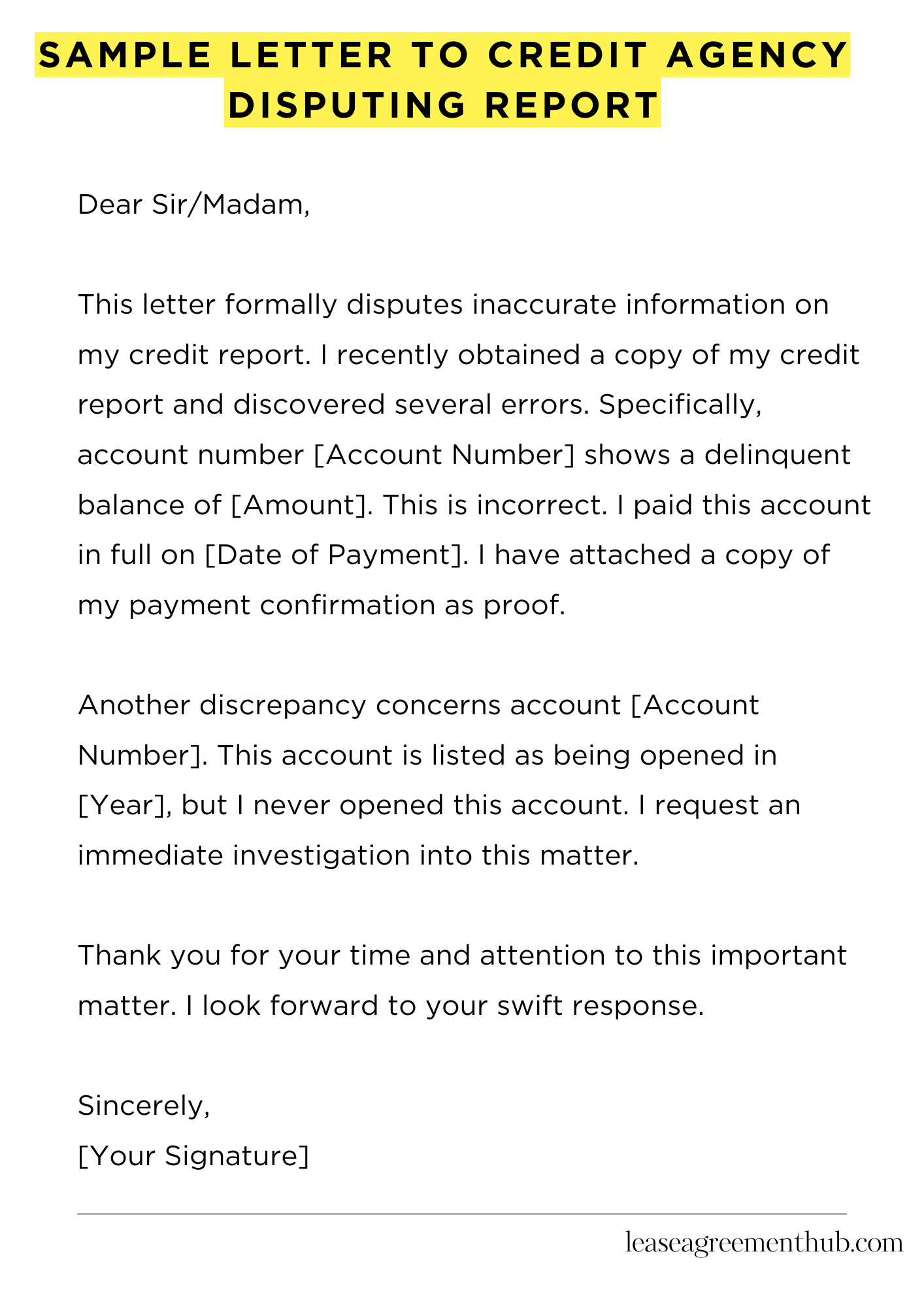A sample letter to a credit agency disputes inaccurate information on your credit report. Its purpose is to correct errors and protect your credit score.
This article gives you examples of these letters. We provide templates to help you write your own. These samples make the process easier.
Use our examples. Create your own effective dispute letter. Improve your credit report today.
Sample Letter to Credit Agency Disputing Report
[Your Name]
[Your Address]
[Your Phone Number]
[Your Email Address]
[Date]
[Credit Agency Name]
[Credit Agency Address]
Dear Sir/Madam,
This letter formally disputes inaccurate information on my credit report. I recently obtained a copy of my credit report and discovered several errors. Specifically, account number [Account Number] shows a delinquent balance of [Amount]. This is incorrect. I paid this account in full on [Date of Payment]. I have attached a copy of my payment confirmation as proof.
Another discrepancy concerns account [Account Number]. This account is listed as being opened in [Year], but I never opened this account. I request an immediate investigation into this matter. This inaccurate information is damaging my credit score and needs correcting promptly.
Please remove these inaccuracies from my credit report. I expect a written confirmation of the corrections within 30 days. My credit report significantly impacts my financial life, and the prompt resolution of this issue is crucial. Failure to correct these errors will force me to consider further action.
Thank you for your time and attention to this important matter. I look forward to your swift response.
Sincerely,
[Your Signature]

How to Write a Sample Letter to Credit Agency Disputing a Report
Understanding the Importance of Precision
Accuracy is paramount when challenging a credit report. Ambiguity breeds dismissal. Your letter must be meticulously crafted, providing irrefutable evidence to substantiate your claims. Vague assertions will be summarily rejected. Employ a formal, business-like tone throughout.
Gathering Your Arsenal: Essential Documentation
Before initiating the missive, amass all pertinent documentation. This includes but isn’t limited to: the erroneous credit report itself, supporting financial records (bank statements, payment receipts), and any communication with the creditor concerning the disputed item. The more robust your evidence, the stronger your case.
Structuring Your Epistolary Assault: A Formal Approach
Your letter should follow a standard business letter format. Begin with your contact information and the date. Address the letter to the appropriate credit agency department—often a dedicated dispute resolution unit. Clearly state your intent to dispute a specific item on your report. Be specific; don’t be vague.
The Art of Articulation: Clearly Stating Your Grievances
Clearly identify the inaccurate entry. Provide a detailed explanation of why you believe it’s incorrect. Cite specific dates, amounts, and any corroborating evidence. A chronological account of events adds weight. Remember, brevity is not your friend; thoroughness is.
Providing Irrefutable Evidence: The Cornerstone of Your Argument
This section requires meticulous attention. Attach copies of all supporting documentation. Maintain originals for your records. Use clear, concise language. Avoid hyperbole or emotional outbursts. Present a cogent argument supported by incontrovertible facts. This is where your case stands or falls.
Concluding with a Call to Action: Demanding Resolution
Conclude by explicitly requesting the correction of the disputed item. State your expectation of a timely response and the preferred method of communication (e.g., email, mail). Include a deadline for their action. Maintain a professional, yet assertive tone.
Post-Dispatch Procedures: Tracking and Follow-up
Retain a copy of your letter and all supporting documentation. Send your letter via certified mail with return receipt requested to ensure delivery and proof of sending. Follow up after a reasonable time frame if you haven’t received a response. Persistence is key in achieving a favorable outcome.
FAQs about sample letter to credit agency disputing report
What information should I include in my dispute letter?
Your letter should clearly state the specific inaccuracies you’re disputing, including the account number, creditor name, and the nature of the error. Include supporting documentation such as copies of receipts, payment confirmations, or other evidence that contradicts the reported information. Your contact information should also be included.
How do I send my dispute letter to the credit agency?
Most credit agencies provide instructions on their websites for submitting disputes. Common methods include certified mail (for proof of delivery), fax, or online portals. Always retain a copy of your letter and any proof of delivery for your records.
What if the credit agency doesn’t resolve the dispute?
If your dispute is not resolved to your satisfaction, you can contact the credit agency again, escalating your concern to a supervisor. You may also consider filing a complaint with the Consumer Financial Protection Bureau (CFPB).
How long does it take for a credit agency to respond to a dispute?
Credit agencies typically have 30 days to investigate and respond to your dispute. However, this timeframe can vary depending on the complexity of the issue and the agency’s workload.
What if the disputed item is a legitimate debt?
If the item is a legitimate debt, acknowledging the debt in your letter while still disputing the accuracy of the reported information may be helpful. You can request a validation of the debt and potentially negotiate a payment plan if you are unable to pay the full amount.
Related: